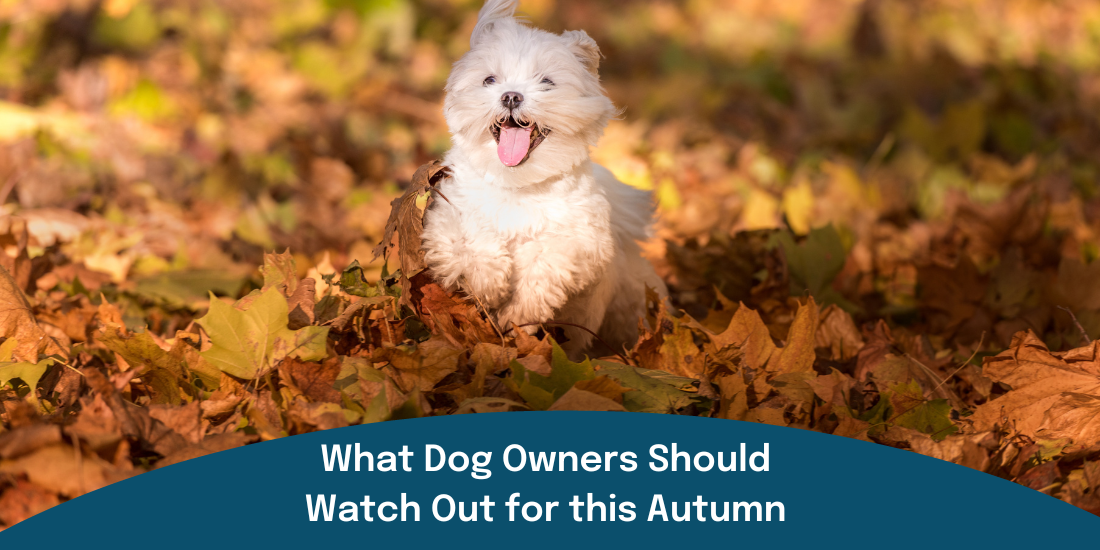
What Dog Owners Should Watch Out for this Autumn
|
|
Time to read 5 min
|
|
Time to read 5 min
Whilst we think of summer as a great time to make the most of getting outdoors with our dogs, with early morning light and longer evenings…the smells and changes of season can be wonderfully exciting for your dog!
The noise of those golden crunchy leaves beneath your feet, muddy slushy puddles and wrapping up to brace that wet and windy weather can bring back that excitement to how we connect with our dogs and nature!
However, today we’re going to discuss some of the potential dangers associated with dogs and autumn. So let’s cover them separately.
Acorns appear to us, on the outside at least, as pretty harmless. But did you know they contain a toxin called ‘tannic acid’ that could make your dog sick or really upset their stomach? Now whilst green acorns contain the largest amounts of these tannins, brown ones contain less. Despite this, try your best to avoid your dog ingesting these as they can present further health complications.
The toxin found in conkers is called aesculin which can quickly make your dog sick or, like acorns, cause quite a bad tummy upset. Since they’re particularly bitter, your dog probably won’t turn to nibbling conkers all that often, but still, it’s best they avoid eating them altogether. Aside from being highly toxic in large amounts, conkers are also a major choking hazard as they’re quite large and can get lodged in your dog’s throat.
Not well known among many people, toxic (and even deadly) toadstools or fungi aren’t just those big bright red ones you see dotted around the woodland path. Toadstools come in all shapes, colours and sizes.
Of course, whilst some mushrooms are edible - and only if you’re an expert and know exactly what you’re doing - many are not and can cause serious illness and even death. So we have to be super careful if we see our dogs even remotely close to these. And it’s worth noting that whilst some can cause side effects almost immediately, there are types of wild mushrooms and toadstools that present their symptoms days and weeks after ingestion. So here’s what to do if your dog has eaten a toadstool, funghi or wild mushroom - or even if you suspect they have:
At least half of all dogs will be frightened of fireworks - and the VAST majority of owners notice a change in their dogs’ behaviour. Celebrations like Bonfire Night can be stressful since they also have a superb sense of hearing (as we know), so the explosions that we hear are often amplified for our dogs. Because dogs don’t realise what’s happening, they don’t understand what is coming next.
Here are some tips we hope you’ll find helpful to make it as stress-free as possible for your four-legged bestie.
As the evenings draw in, it’s a good idea to help make both you and your dog more visible. It won’t come as a surprise that road traffic accidents are more common during the autumn/winter months so things like bright reflective clothing, light-up collars and leads are important.
Temperatures begin to gradually drop during autumn, and this is when trees begin to drop their fruits. However, you need to be aware that some seeds, pips and fruit stones do contain toxins that are potentially harmful to your dog’s health, if ingested. Rotting or fermenting fruit that’s been on the ground a little while is also a hazard and can create upset stomachs very easily.
Spring and autumn are the most common times these little pests come alive, however, they can feed from dogs during any season. Ticks are nasty - they can pick up and transfer diseases from animal to animal (including us) which can lead to long-term illnesses! A simple tip is after a walk in the countryside or out in the woods, always be sure to check for any strange lumps or bumps - these could be ticks.